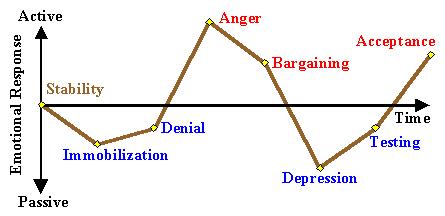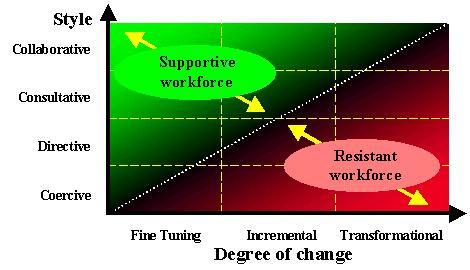Cultural Change Programs
What are the effects of the continuous change in business?
Most organisations undergo significant changes that have an impact on the people who work in the business. Changes including ownership, restructuring, competition, the introduction of new technology, increased / decreased workloads and new senior management or directors.
As a result, employees are often asked to change their work habits and to fit in with a new way of doing things. If the employees resist, often customer service, productivity and staff morale suffers. Sometimes, clients and employees are lost in the process.
Why do people resist change?
It is normal human emotion to feel comfortable with the current way and to resist learning a new
and unfamiliar way of doing things. This is true for personal as well as business life. Most people
will go through a common cycle of emotions that involve denial, anger and finally acceptance.
Negative
Response
To
Change

Why can’t we let the change just run its course?
Mostly, the stakes are too high to allow the emotion to spill over or “poison” the positive parts of
the business. Customer may be lost or key staff may leave. Either way, the reputation of the
company will ultimately suffer.
Usually, the management of the business is engaged with the increased workload created by the change, and “fighting the fires” that keep happening as a result of the change. Further they are often viewed unfairly by staff as being the “architects” of the problems and not part of the solution. Even if the management’s people skills are of a high order, they are usually too close to the problems to be effective.
Usually, the management of the business is engaged with the increased workload created by the change, and “fighting the fires” that keep happening as a result of the change. Further they are often viewed unfairly by staff as being the “architects” of the problems and not part of the solution. Even if the management’s people skills are of a high order, they are usually too close to the problems to be effective.
What should be done to repair the problems, before it’s too late?
The key component of a change management program is to enable the workforce to feel “some
control” over what is happening to them and to own the change, rather than have it imposed.
“Change is exciting when done by us, but threatening when done to us!”
“Change is exciting when done by us, but threatening when done to us!”
How do we give the workforce ownership, without losing control?
Communication (real, two-way communication) and participation are the secrets to making changes
“stick” and getting everyone possible behind the changes.
Ongoing communications that addresses employees concerns, answers questions, listens and shares
information about the need for change, need to be implemented.
Participation in “non critical decisions” is also extremely important. People need to feel that the direction that the company is taking is practical and takes into account their needs and those of the other business stakeholders. The overall direction of the change may not deviate, however “hearts and minds” will be won. Ultimately, communications and participation are all about rebuilding trust, which is the only way forward. The degree of change required and the management styles of the business will also have a significant impact on the level of resistance that employees will show.
Participation in “non critical decisions” is also extremely important. People need to feel that the direction that the company is taking is practical and takes into account their needs and those of the other business stakeholders. The overall direction of the change may not deviate, however “hearts and minds” will be won. Ultimately, communications and participation are all about rebuilding trust, which is the only way forward. The degree of change required and the management styles of the business will also have a significant impact on the level of resistance that employees will show.

How can Silent Partner Consulting help?
As change management and human resource experts, we work with the people in the business to
generate improved communication, participation and trust. As we are not emotionally involved with
the change, we are able to identify the real barriers to effective change implementation and facilitate
ongoing improvement strategies. Our program usually centres on workshops, working groups and
one-on-one work, where issues are identified and strategies are developed. Overall the aims are to:
- Encourage employees to address their concerns.
- Help employees to understand their roles in securing the business’s future.
- Get employees to work together again and to rebuild trust.
How much will it cost?
We do not use the latest business fad or a pre determined program. We will develop and deliver a
tailored program that will fit the specific need of the worksite. Accordingly, we start by conducting
a situational analysis and a proposal, which are complimentary. The proposal costs are based on the
expected hours involved, at our standard hourly consulting rate. Accordingly, any program can be
lengthened or reduced to match financial and operational constraints.
Sound interesting?
Contact Silent Partner Consulting on +61 3 9626-2421 or e-mail to general@spconsulting.com. au
for an obligation free discussion about how we can help your business excel.
